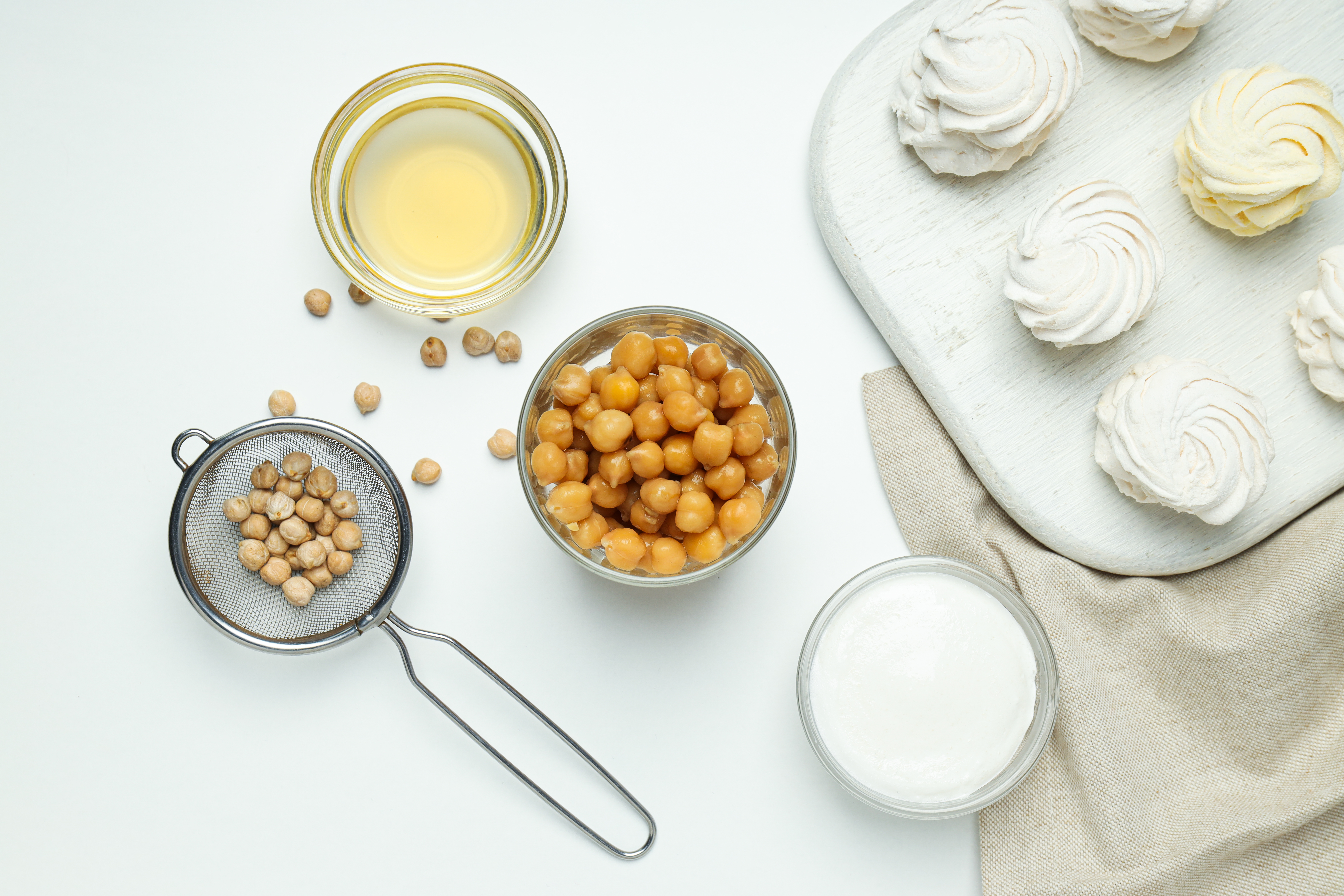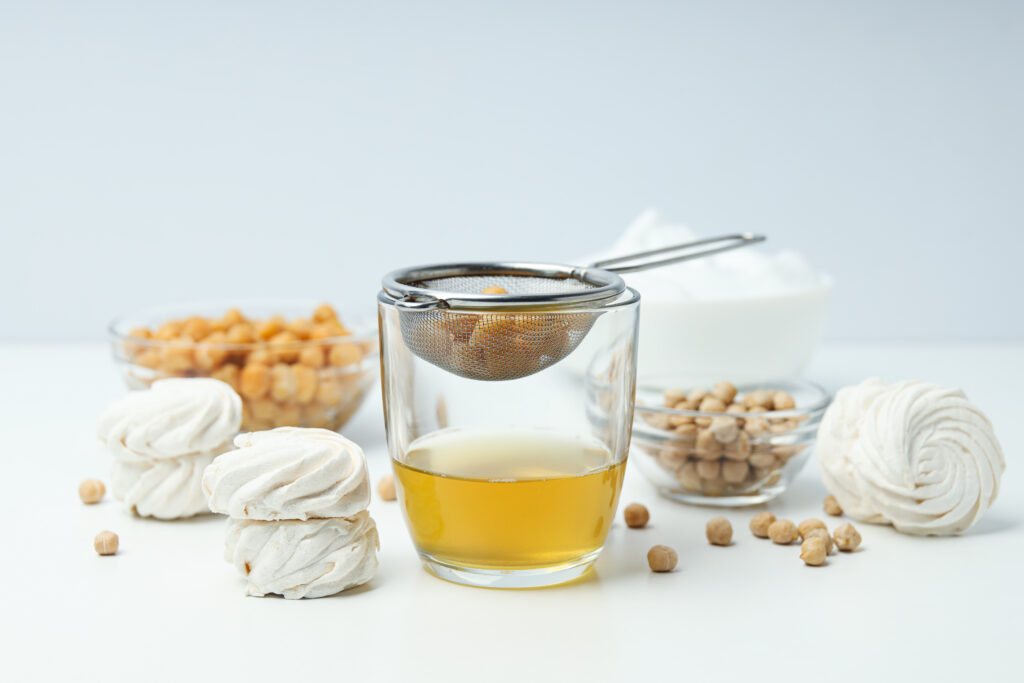
In the ever-evolving world of culinary arts, the search for innovative and sustainable ingredients has led to the discovery of aquafaba, a relatively unknown yet remarkable substance. Derived from a rather unexpected source – the liquid found in cans of chickpeas or the water left behind after cooking legumes – aquafaba has taken the vegan and vegetarian cooking community by storm.
What is Aquafaba?

Aquafaba is the viscous, starchy liquid that is leftover after cooking or canning legumes, most commonly chickpeas (garbanzo beans). The name “aquafaba” is derived from Latin, with “aqua” meaning water and “faba” meaning bean. It is an increasingly popular ingredient in vegan and vegetarian cooking due to its remarkable ability to mimic the functional properties of egg whites. Specifically, when aquafaba is whipped, it can create stable foams and emulsions, much like beaten egg whites, making it a valuable substitute for eggs in various recipes.
The key properties of aquafaba that make it an excellent egg replacement in cooking and baking include its emulsification capabilities, foam formation, and the ability to gel when heated. These properties allow it to be used in a wide range of dishes, from meringues and mayonnaise to cakes and ice creams, providing a versatile and plant-based and healthier alternative to eggs.
Aquafaba has gained popularity in the vegan and vegetarian communities for its versatility, as well as its potential to reduce food waste by making use of an ingredient that is often discarded. It has also shown promise in reducing the environmental impact of food production, as it allows for the creation of egg-like textures and structures without relying on animal agriculture.
What is Aquafaba made up of?
Aquafaba is primarily composed of water, soluble plant proteins, starches, and small amounts of minerals. The specific composition can vary depending on the source of the aquafaba, as it is typically derived from cooking or canning legumes such as chickpeas (garbanzo beans). Here’s a breakdown of the key components:
Water: The majority of aquafaba’s composition is water, typically around 90% or more. This high water content provides the liquid base for aquafaba.
Soluble Proteins: Aquafaba contains soluble proteins, such as globulins and albumins. These proteins are the essential components that give aquafaba its unique properties, allowing it to mimic the functional properties of egg whites when whipped.
Starches: Starches, which are complex carbohydrates, are also present in aquafaba. These starches contribute to the thickening and gelation properties of aquafaba when it is heated, making it suitable for certain culinary applications.
Minerals: Aquafaba contains small amounts of minerals, including potassium, calcium, and magnesium, which can influence its taste and behaviour in recipes.
It’s important to note that the specific composition of aquafaba can vary depending on factors such as the type of legume used (chickpeas, black beans, etc.), the cooking method, and whether the liquid comes from canned or cooked legumes. Despite these variations, the soluble proteins in aquafaba are the primary contributors to its ability to create foams and emulsions, making it a valuable egg white substitute in vegan and vegetarian cooking.
What are the benefits of aquafaba?
Aquafaba offers several benefits that have made it increasingly popular in vegan and vegetarian cooking, as well as in some traditional cooking applications. Here are some of the key benefits of aquafaba:
- Vegan and Vegetarian Egg Substitute: One of the primary benefits of aquafaba is its ability to mimic the properties of egg whites, making it an excellent egg substitute in various recipes. This is particularly valuable for those who follow a vegan or vegetarian diet and for individuals with egg allergies.
- Versatility: Aquafaba is incredibly versatile and can be used in both sweet and savoury dishes. It can be used to create a wide range of recipes, including meringues, mayonnaise, whipped cream, macarons, cakes, Whipped cream, cocktails and more.
- Reduces Food Waste: Aquafaba is made from a by-product of cooking legumes, such as chickpeas. Using aquafaba helps reduce food waste by utilizing a liquid that is often discarded. This aligns with sustainability and eco-friendly cooking practices.
- Sustainability: As the demand for plant-based and vegan options increases, aquafaba contributes to sustainability efforts by reducing reliance on animal agriculture. It provides a plant-based alternative to egg whites, which is more environmentally friendly.
- Lower in Fat and Cholesterol: When used as an egg substitute, aquafaba is lower in fat and cholesterol compared to eggs. This can be beneficial for those looking to reduce their intake of these dietary components.
- Allergen-Friendly: Aquafaba is free from common allergens like eggs and dairy, making it suitable for individuals with various dietary restrictions and allergies.
- Cost-Effective: Using aquafaba can be cost-effective, especially if you cook legumes regularly. It allows you to make use of an ingredient that might otherwise go to waste.
- Plant-Based Protein: Aquafaba contains plant-based proteins, making it a source of protein for those following plant-based diets. This is particularly valuable in a world where plant-based protein sources are in demand.
- Texture and Structure: Aquafaba contributes to the texture and structure of dishes, allowing for light and airy textures in recipes like meringues, macarons, and whipped cream.
- Innovation in Culinary Arts: The use of aquafaba has led to creative innovations in the culinary world, with chefs and home cooks experimenting with new and exciting plant-based recipes.
Uses of Aquafaba
Aquafaba is a versatile and unique ingredient with a wide range of culinary applications. Here are some of the common uses of aquafaba in cooking and baking:
- Whipped Aquafaba: Aquafaba can be whipped to create a foam with a texture similar to whipped egg whites. This is the basis for many applications, including:
- Vegan Meringues: Whipped aquafaba, when sweetened with sugar, can be used to make vegan meringues, Pavlovas, and other airy, sweet treats.
- Vegan Whipped Cream: Whip aquafaba with sugar and flavourings to create a dairy-free whipped cream alternative that can be used as a topping for desserts.
- Egg White Replacement: Aquafaba serves as an excellent substitute for egg whites in various recipes. Some examples include:
- Vegan Baking: It can be used as an egg substitute in recipes for cakes, cookies, brownies, and other baked goods.
- Mayonnaise: Aquafaba can be used as a base for making vegan mayonnaise, providing the necessary emulsification properties.
- Binders and Leavening Agents: Aquafaba can function as a binder and leavening agent in recipes:
- Vegan Pancakes and Waffles: Aquafaba can replace eggs in pancake and waffle recipes to help achieve a light and fluffy texture.
- Vegan Quiches and Frittatas: It can be used to provide structure and bind ingredients in savoury dishes like quiches and frittatas.
- Emulsifiers: Aquafaba has emulsification properties that make it useful in recipes such as:
- Vegan Mayonnaise: It can be the primary ingredient in vegan mayonnaise recipes, where it helps create a creamy, stable texture.
- Salad Dressings: Aquafaba can be used to emulsify salad dressings, ensuring that the oil and vinegar combine evenly.
- Sweets and Desserts: Aquafaba can be incorporated into sweet recipes to achieve specific textures and flavours:
- Vegan Ice Cream: It can help create a light and creamy texture in vegan ice cream recipes.
- Custards and Puddings: Aquafaba can be used to achieve the creamy, smooth texture typical of custards and puddings.
- Glazing: Aquafaba can be used as a glaze to add shine and color to baked goods like bread, rolls, and pie crusts.
- Binding Mixtures: In recipes like veggie burgers and veggie meatballs, aquafaba can be used as a binding agent to hold ingredients together.
- Foaming Agent: It can be used as a foaming agent in vegan cocktails, such as the replacement for egg whites in cocktails like whiskey sours.
- Innovation: With the creativity of chefs and home cooks, new uses for aquafaba continue to emerge. Experimentation is ongoing in various cuisines and styles of cooking.
Where can one buy it from? How much does it cost to the pocket?

Aquafaba can be easily obtained at home by using the liquid that results from cooking or canning legumes, such as chickpeas, or by using the liquid from a can of beans. Here’s how you can find and make aquafaba:
Canned Beans: The most convenient way to obtain aquafaba is by purchasing canned beans, particularly chickpeas (garbanzo beans). When you open a can of beans, you’ll find the liquid inside, which is the aquafaba. Make sure to choose canned beans with no added salt or seasonings if you want a neutral-tasting aquafaba.
Cooked Legumes: If you prefer to use cooked legumes, you can simply cook your own chickpeas, black beans, lentils, or other legumes at home. The liquid remaining from cooking these legumes is your homemade aquafaba.
As for pricing, the cost of aquafaba can vary depending on where you live and where you purchase it. Here are some general guidelines:
- Canned Beans: Canned beans are readily available in most grocery stores, and the price can vary based on the brand, location, and the type of beans. A can of beans typically costs a few dollars, and you get both the beans and the aquafaba.
- Cooked Legumes: If you cook your own legumes, the cost will depend on the price of the dried legumes and the energy used for cooking. Dried legumes are generally affordable and can be bought in bulk for even more savings.
It’s worth noting that aquafaba is a by-product of using legumes, and its cost is relatively low. As a result, it’s an economical and sustainable option for creating vegan and vegetarian dishes, and it can help reduce food waste by making use of an ingredient that is often discarded. Making aquafaba at home by cooking your own legumes is usually the most cost-effective option.
Conclusion
In the world of culinary arts, aquafaba has emerged as a revolutionary ingredient, transforming how we approach vegan and vegetarian cooking. With its roots in French culinary history, its scientific properties, and a myriad of culinary applications, it has quickly found its place in kitchens around the world. Its environmental benefits and potential to reduce food waste make it not only a delicious choice but also a sustainable one. As we continue to explore the versatility of aquafaba, it’s clear that this unassuming liquid is here to stay, offering a bright and flavourful future for plant-based cuisine.

